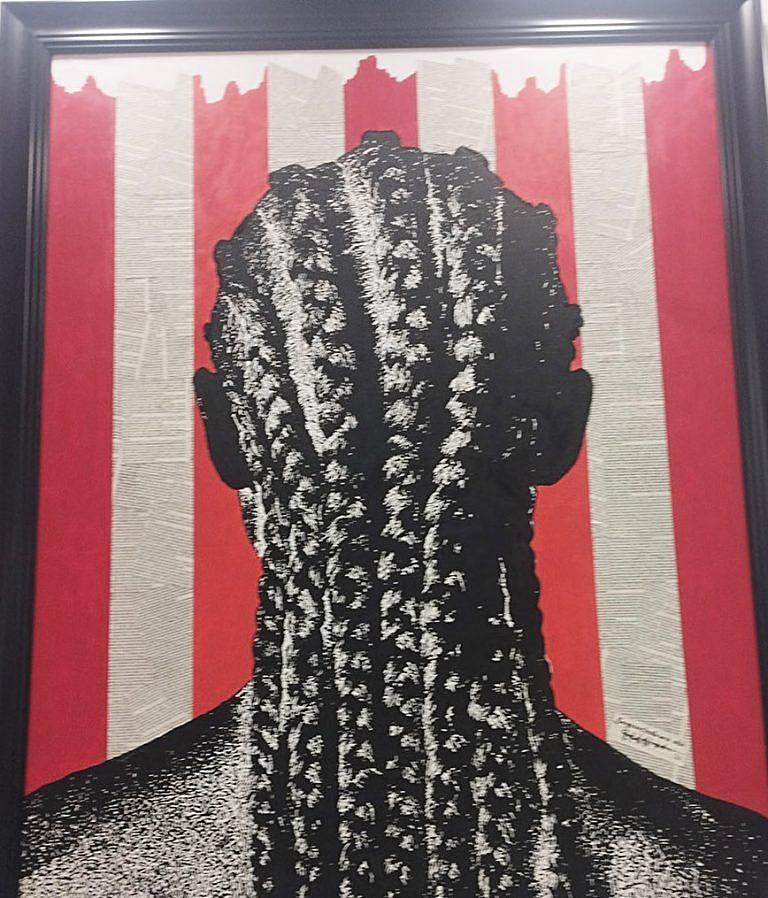Yinka Olatunbosun
Overflowing with enthusiasm from the opening of his solo exhibition, Somtochukwu Obi confidently navigated the crowded room inside Thought Pyramid Art Gallery, where his works are currently on display. Entitled “The Being Us,” the exhibition delves into deep philosophical themes as the artist explores the notion of identity and human existence, particularly in the context of being Nigerian.
Obi, a talented visual artist born in Lagos, draws heavily on his personal experiences and the realities of Nigerian society to create distinctive pieces of artwork on canvas. With a background in architecture from Covenant University in Ota, he uses an architectural ink pen as his primary tool for portraiture.
During his childhood, he developed a unique skill of creating exact replicas of prominent Nigerian leaders’ portraits directly from Naira notes. While his father initially envisioned him pursuing a career in pharmacy, Obi’s passion for art led him to study architecture instead.
Intriguingly, his father, who had just delivered the opening remarks, captured the bustling scene with his mobile phone.
Obi explained that he discovered architectural ink pens while using them for drawing building blueprints. Realizing their potential for art, he developed his own artistic style, utilizing the ink pen for portrait art. Initially, most of his works from 2017 to 2020 were commissioned by clients, he revealed.
“The Being Us” series, which serves as a window into Obi’s soul, acts as a platform to depict the multifaceted stories, experiences, and environments that define Nigeria as a nation.
The presence of women frequently features in his body of work. In one piece titled “Better Things to Come,” the artist showcases his signature ink pen style in a mixed media painting that celebrates indigenous cultural identity, particularly African braids.
He emphasized that women have played crucial roles in shaping the history of great men and women throughout time and being a woman should not be seen as a disadvantage.
Additionally, reflecting on what he perceived as the broken promises of the ruling class, Obi presents paintings that raise questions about governance and Nigeria’s current economic state.
Another noteworthy piece, titled “When Things Were Simple,” evokes memories of Obi’s childhood and the innocence of a bygone era. This artwork intricately captures an African child’s existence before the advent of the internet, rekindling layers of nostalgic experiences.
A particularly captivating piece, “I’m Ibo, So What About It?,” depicts Obi’s encounter with tribal sentiments while searching for a studio apartment in Lagos. He recalls a powerful response to such discrimination: “The landlord asked, ‘Are you Ibo or Yoruba?’ Knowing that answering ‘Ibo’ would be seen as wrong, I confidently replied, ‘I’m Ibo. What about it? Aren’t we all facing the same economic struggles? What’s wrong with being Ibo?'”
Ovie Omatsola, the exhibition director of Thought Pyramid Art Centre and curator of the show, commended the artist’s meticulous effort in presenting the exhibition and highlighted why art enthusiasts are drawn to these showcased works. “Collectors are not just appreciating the aesthetics of the works but also considering them as investment alternatives,” he explained.
Mrs. Toke Benson-Awoyinka, the Lagos State Commissioner of Tourism, Arts, and Culture, also attended the exhibition. After viewing Obi’s works, she expressed her support, saying, “I promised to come because I want to encourage him and others like him. Just follow your passion. You are telling the Nigerian story in a unique way.”
Eghosa Noel Ekhaese, a lecturer at Covenant University’s Architecture Department and a strong supporter of Obi’s work, recalled how he quickly realized Obi’s natural artistic talent within his architectural projects. “He is incredibly focused,” Ekhaese said. “I recognized his artistic abilities during his first year. Although he has a humorous side, you won’t truly understand how serious he is until you get to know him. While we teach design in architecture, Somto taught himself art.”
The exhibition will run until September 14.

